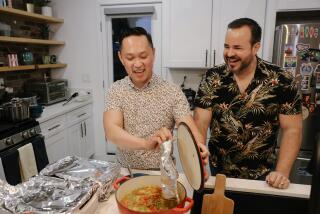It’s Cigar Production With a Cuban Twist
- Share via
MANILA — His fingers working nimbly like a chef preparing a Chinese spring roll, Arturo Cruz wraps prime tobacco leaves gingerly into a bundle.
“This is how the Cubans do it,” says Cruz, a cigar maker for 20 years. “We no longer fold the leaves, which is how we did it before.”
Cruz says the method, believed to keep the tobacco more moist, is one of several prized techniques that his company, La Flor de la Isabela, has learned from the Cuban cigar master who developed that country’s famed Cohiba cigar.
La Flor, the biggest of the Philippines’ five cigar companies, hired cigar master Alfredo Salinas to train its 352 cigar rollers to capture the illusive quality of world-famous Havana cigars.
The company, along with other Philippine cigar makers, hopes a careful imitation of Cuban cigars will allow it to take advantage of the growing trendiness of cigars around the world, export manager Javier San Juan says.
La Flor produces 12 million cigars a year. Of those, 3 million are smoked in the Philippines, another 3 million are exported to Spain and the rest are sold to 22 other countries. It hopes to be hand-rolling 35 million cigars annually within five years.
The ties between Philippine tobacco makers and Cuba go back centuries. In the late 1500s, a Spanish galleon plying the busy Manila-Acapulco trade route run by Spain brought 200 ounces of tobacco seeds from Cuba. Those seeds were distributed among Spanish friars across the Philippines. But it was in a valley in northern Cagayan province where they found the best soil and climate.
Older women in the north quickly developed a taste for loosely rolled sausage-size cigars--and to this day smoke them with the burning end inside their mouths for extra warmth during the cool planting season.
The islands’ Spanish colonial rulers were a ready market for higher-quality cigars, and hand-crafting techniques passed on from Spain to Cuba and then the Philippines were used by generations of Filipino workers.
However, those traditional methods were refined by cigar makers in Cuba in ways that greatly affect cigar taste, Cruz says.
The techniques shared by Salinas include the use of a flavor-enhancing vegetable paste instead of water for fastening the wrappers, Cruz says.
Salinas also recommended the installation of humidifying chambers and extra storage and aging rooms in the factory.
La Flor’s top-of-the-line cigar, the Don Juan de Urquijo, the closest in taste to a Cuban cigar, sells in the Philippines for 226 pesos ($7) each, compared to 1,500 pesos ($50) for a genuine Cuban.
The Don Urquijo is a blend of seven tobacco varieties, including a wrapper from Connecticut, Indonesia or Honduras, a binder usually from Indonesia, and filler from the Philippines.
While following Cuban production techniques, Philippine cigar companies are modeling their sales methods on the United States. Like American makers, they hope to glamorize cigars by linking them to celebrities and marketing them in exclusive hotel shops.
Andy Marinkovich, senior editor of New York-based Smoke magazine, rates Philippine cigars as good but says they are not as full-flavored as Cuban cigars.
“They are done pretty well. People seem to like their pretty mild and smooth taste. It’s a cigar I would recommend to beginning cigar smokers,” he says.
San Juan, La Flor’s export manager, says the company is working hard to refine its techniques and make sure its expansion plans go smoothly.
“We’re always trying to improve quality,” he says.

